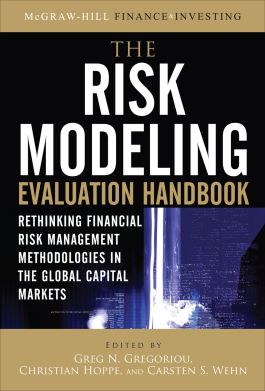The Risk Modeling Evaluation Handbook: Rethinking Financial Risk Management Methodologies in the Global Capital Markets
Receive via shipping:
- Print bound version of the complete text
1. The Problem of Systemic Risk as a Strong Case for the Lender of Last Resort
2. Learning from Previous Financial Crises and the Necessity to Recognize Liquidity Shocks and the Limits of Arbitrage
3. Valuing Political Risk
Section Two: Model Risk Related to Equity and Fixed Income Investments
4. Analysts' Forecasts, Market Risk Premia, and Estimations of Expected Security Returns
5. The Market-timing Ability of Australian Superannuation Funds
6. Caring About Stylized Features of Asset Returns
7. Price Transmissions and Market Risk in Financial Markets
8. Volatility Asymmetry and Leverage
9. The Effects of Different Parameter Estimation Methods on Option Pricing
10. Effects of Benchmark Misspecification on Risk-adjusted Performance Measures
Section Three: Model Risk Related to Credit and Credit Derivatives Instruments
11. The Term Structure of Risk in Emerging Markets and Implications for the Carry-trade
12. A Strategic Management Insight into Model Risk in Ratings
13. Tranching a Securitization with the Supervisory Formula
14. Model Risk in the Quantitative and Qualitative Credit Process
15. Model Risk in Highly Correlated Credit Portfolios of Object Financing
Section Four: Model Risk Related to Valuation Models
16. Concepts to Validate Valuation Models
17. Model Risk in the Context of Valuing Equity Derivatives
18. Techniques for Mitigating Model Risk
Section Five: Limitations to Measure Risk
19. Beyond VaR
20. VaR Computation in a Non-stationary Setting
21. Copula-VaR and Copula-VaR-GARCH Modeling
22. Small-sample Properties of EVT Estimators
Section Six: Modeling Market Risk for Risk Markets
23. Model Risk in Counterparty Exposure Modeling
24. Model Risk for Credit Risk Modeling
25. Model Risk in Credit Portfolio Models
26. Model Risk for Market Risk Modeling
27. Evaluating the Adequacy of Market Risk Models
28. Model Risk Related to Operational Risk Models
Section Seven: Economic Capital and Asset Allocation
29. Validation of Economic Capital Models
30. Robust Asset Allocation Under Model Risk
31. The Asset-liability Management Compound Option Model
The first in-depth analysis ofinherent deficiencies in present practices
“A book like this helps reduce the chance of a future breakdown in risk management.”
Professor Campbell R. Harvey, the Fuqua School of Business, Duke University
“A very timely and extremely useful guide to the subtle and often difficultissues involved in model risk—a subject which is only now gaining theprominence it should always have had.”
Professor Kevin Dowd, Nottingham University Business School, the University of Nottingham
“This book collects authoritative papers on a timely and important topic . . .and should lead to many new insights.”
Professor Philip Hans Franses, Erasmus School of Economics, Erasmus University
“Inadequate valuation and risk management models have played their part intriggering the recent economic turmoil felt around the world. This timely book,written by experts in the field of model risk, will surely help risk managers andfinancial engineers measure and manage risk effectively.”
Dr. Fabrice Douglas Rouah, Vice President, State Street Corporation
“This invaluable handbook has been edited by experts . . . and should prove to beof great value to investment finance and credit risk modelers in a wide range ofdisciplines related to portfolio risk, risk modeling in finance, international moneyand finance, country risk, and macroeconomics.”
Professor Michael McAleer, Erasmus School of Economics, Erasmus University
About the Book:
If we have learned anything from the globalfinancial collapse of 2008, it is this: themathematical risk models currently used byfinancial institutions are no longer adequatequantitative measures of risk exposure.
In The Risk Modeling Evaluation Handbook,an international team of 48 experts evaluatesthe problematic risk-modeling methodsused by large financial institutions and breaksdown how these models contributed to thedecline of the global capital markets. Theirconclusions enable you to identify the shortcomingsof the most widely used risk modelsand create sophisticated strategies for properlyimplementing these models into your investingportfolio.
Chapters include:
- Model Risk: Lessons from Past Catastrophes(Scott Mixon)
- Effect of Benchmark Misspecification on RiskadjustedPerformance Measures (Laurent Bodsonand George Hübner)
- Carry Trade Strategies and the Information Content ofCredit Default Swaps (Raphael W. Lam andMarco Rossi)
- Concepts to Validate Valuation Models(Peter Whitehead)
- Beyond VaR: Expected Shortfall and Other CoherentRisk Measures (Andreas Krause)
- Model Risk in Credit Portfolio Modeling(Matthias Gehrke and Jeffrey Heidemann)
- Asset Allocation under Model Risk (Pauline M. Barrieuand Sandrine Tobolem)
This dream team of the masters of riskmodeling provides expansive explanations ofthe types of model risk that appear in riskmeasurement, risk management, and pricing,as well as market-tested techniques formitigating risk in loan, equity, and derivativeportfolios.
The Risk Modeling Evaluation Handbook is thego-to guide for improving or adjusting yourapproach to modeling financial risk.

